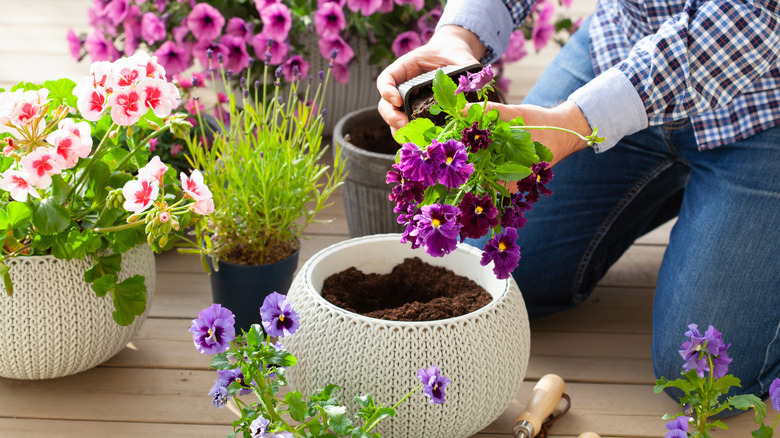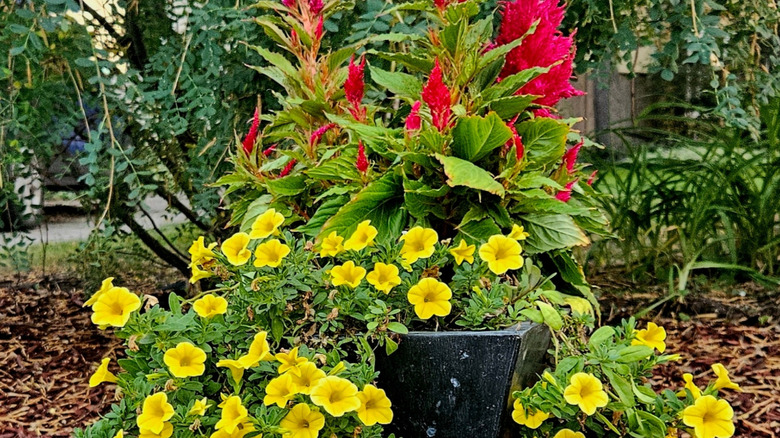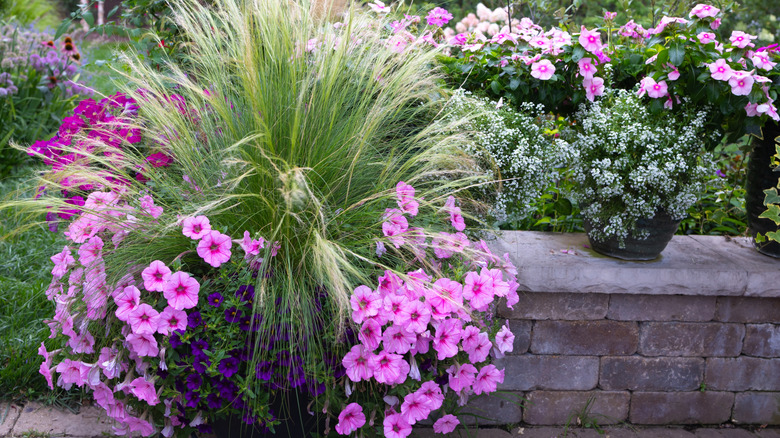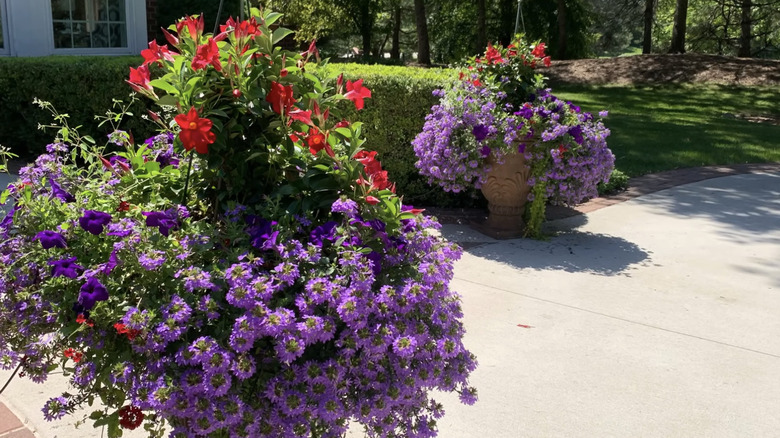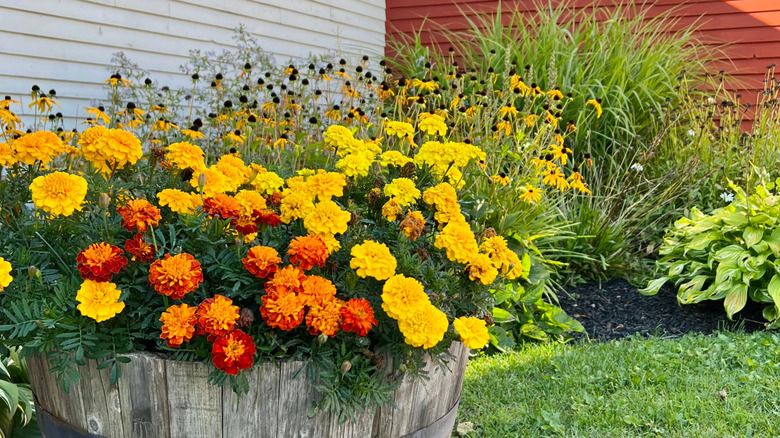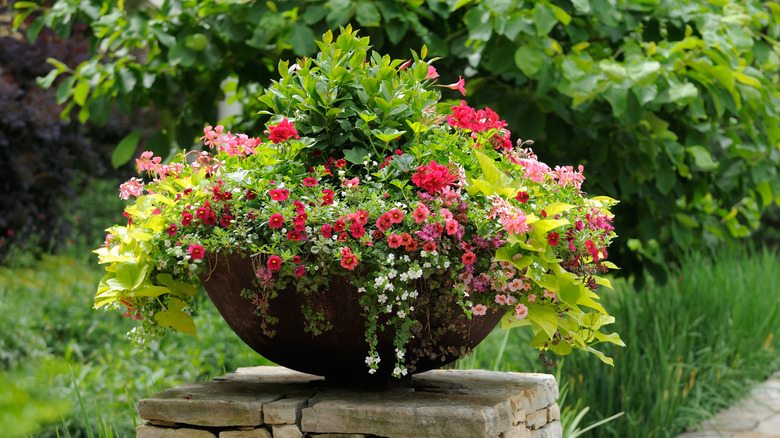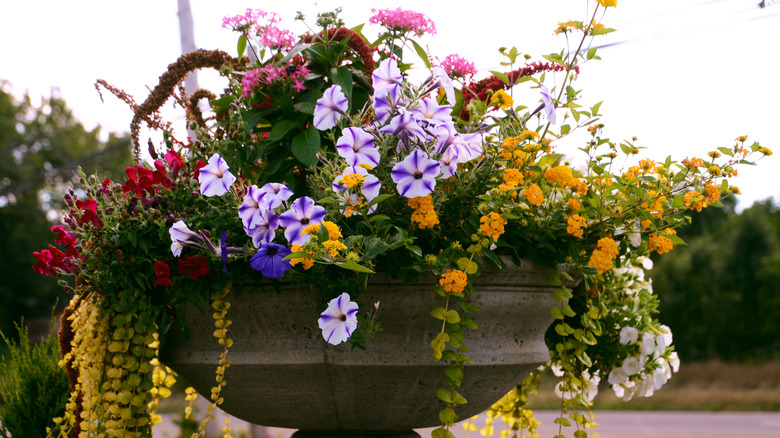Full-Sun Flower Combos That Will Make Your Patio Pots Pop With Colors
If your patio gets full sun (about six hours of direct exposure), it might be difficult to keep potted flowers from drying out or getting scorched in the heat. Luckily, there are plenty of colorful flower varieties that thrive in full-sun conditions. From striking petunia varieties to geraniums, bidens, and even marigolds (just to name drop a few), there are countless sun-loving options for patio planters that also pack a vibrant punch.
The key to picking winning color combos is to select shades that either contrast or complement one another. Colors that are opposites on the color wheel make a bold statement. Examples include blue lobelia and orange marigolds or purple and yellow Supertunias. You can even pair flowers based on cool or warm tones or those in the same color family.
To get the most color out of container flowers, make sure that you pair compatible plants and stay on top of watering, fertilizing, and deadheading. Also, stick to a simple formula of thriller, filler, and spiller plants so each plant has a chance to shine. Done right, the perfect mix of sun-friendly flowers and foliage plants will give your patio the colorful boost it needs all season long. So without further ado, here are some spectacular flower pot combos that thrive in full-sun spots on your patio.
Petunias, geraniums, marigolds, and other accents create colorful abundance
This full-sun combo wows with its reds, yellows, pinks, and periwinkle-like purples. Yellow African marigolds (Tagetes erecta) and pink zonal geraniums (Pelargonium × hortorum) with variegated leaves fill in the center of the planter and add height. Yellow and red Supertunias (Petunia x hybrida) spill over the edges with eye-catching color, while trailing lobelia (Lobelia erinus) and blue mink (floss flower or Ageratum houstonianum) fill in the gaps and add cool contrast.
To replicate this flower arrangement, you'll need a pot or a planter with enough space for the plants to fill out and produce endless blooms. The size you choose will also depend on how many flowers and varieties you want to include. Consider starting with one zonal geranium for the center, surrounded by three marigolds, two lobelia, and two Supertunias since they will spread and spill. Then, dot any bare space with compact blue mink flowers.
Contrasting celosia and Supertunias will steal the show
Celosia (commonly known as woolflower) and Supertunias (Petunia x hybrida) are an easy, sun-loving container combo that you can plant for a stunning patio display. Celosia works as the thriller with its flame-like flowers, while the Supertunias act as both the filler and spiller of the arrangement. These two flowers come in a wide range of colors, shapes, and sizes, producing completely different looks. Pair a bold red celosia plant with two yellow Supertunia plants, or mix it up with an orange celosia and pink Supertunias for an equally warm color combo. To amp up the drama, consider a fuchsia celosia surrounded by deep plum-colored Supertunias.
When choosing a container, choose a dark neutral planter to ensure the colors and flower shapes really pop. Keep in mind that celosia is available in dwarf and full-size varieties. Dwarf options can get about 6 inches wide and a foot tall, while non-dwarf varieties can be up to three feet tall. So, make sure to choose the right one for your container and arrangement. In square or rectangular containers, plant the celosia toward the back and the Supertunas in the front. For round containers, plant the celosia in the center with two to four Supertunia plants (depending on container size) around it.
Supertunias, million bells, and ornamental grass combine for dramatic foliage and hues
For this show-stopping full-sun combo, you'll need one ornamental grass plant (bonus if you go with pink muhly grass or purple fountain grass for additional color), approximately two Supertunia (Petunia x hybrida) plants in the colors of your choosing, and three plants of million bells (also referred to as Calibrachoa). The grass acts as the thriller, Supertunia as the spiller, and million bells as the filler. This specific arrangement features bright pink Supertunias, deep purple million bells, and Mexican feathergrass (Nassella tenuissima). But it's important to note that Supertunias and million bells come in endless colors and variations — giving you plenty of options to work with.
Plant the ornamental grass toward the back of the planter since it will naturally fill out and could accidentally overshadow the other flowers if placed in the center. Then, fill the front of the container with a mix of two Supertunia plants and one million bell plant in the middle, and watch them spread over time. Due to the size and spread of these plants, consider a 24-by-24-inch pot with good drainage holes. You can also try a 12-by-12-inch pot with one of each plant. Just keep in mind that they might not grow as big.
Wow with bold Prince Tut grass, geraniums, verbena, and sweet potato vine
This beautiful full-sun arrangement pairs bold colors with stunning foliage. It includes a Prince Tut ornamental grass plant, bright pink zonal geraniums, and purple verbena. For spiller appeal, you can also add a purple sweet potato vine to trail down the side. A lime green sweet potato vine would also work, especially when paired with the rest of the flowers' bright pinks, purples, and rich green hues.
We recommend using a gray or black planter for this flower combo, as the neutral base will put all the focus on the bold flower scheme. Plant the Prince Tut grass in the center of the container, since it will grow upwards before fanning out, leaving room beneath for other flowers to spread and flourish. Then, plant three geraniums in a triangular formation around the base of the grass, and add a verbena plant in each gap between them. For this planting scheme, you'll likely need a large container to accommodate the same number of plants, but you can always go bigger or smaller depending on your patio space.
Mandevilla, scaevola, and Supertunias excite with rich color
Combine Mandevilla (also called rock trumpet or by its scientific name: Mandevilla spp.) Scaevola (fan flower), and Supertunias (Petunia x hybrida) in containers for a full-sun wow factor. Red mandevilla vine acts as the central thriller, deep purple Supertunias as the filler, and purple scaevola as the spiller. Remember, you can always mix up the color combos and try different variations. For example, instead of a red mandevilla vine, you could try an orange variety paired with the same purple scaevola and pink Supertunias. Alternatively, you could pair a yellow mandevilla vine with pink scaevola and orange Supertunias for a warm sunset-inspired arrangement.
As for the container color, you can't go wrong with warm terracotta to offset the vibrant flower colors. Just consider using a large, deep urn-style planter with good drainage holes to prevent waterlogging. The planter design will also add even more drama to your patio in addition to the flowers. When it comes to planting, plant the mandevilla vine first, in the center of the urn with a trellis to train it up. As for the scaevola and Supertunias, opt for two of each plant and plant them in a diamond formation.
Blend marigold varieties for a mix of golden and fiery hues
Marigolds aren't just for vegetable gardens. They're also versatile container flowers that deserve a mention. With so many varieties, colors, and hybrids, you can fill a patio planter with only marigolds and get just as much color and interest as you would using different types of flowers. African marigolds (Tagetes erecta) are known for their height, fullness, and bold yellow-orange blooms. French marigolds like Tagetes patula 'Konstance' thrive along the edges of containers because they're smaller, and they have distinct orange-red petals that offer a striking contrast to any pairing. In general, marigolds come in a variety of shades of red, orange, yellow, and even white, giving you plenty of combos to work with. Signet marigolds (Tagetes tenuifolia) can be used to fill in bare spaces in your arrangement, since they're compact and offer eye-catching lace-like petals.
When choosing a flower pot color for marigolds, consider contrasting colors. For example, orange marigolds contrast beautifully with blue planters. As for planting, there are a couple of foolproof layouts. For window boxes or rectangular planters, plant marigolds in staggered rows with shorter varieties in the first row and taller varieties behind. In round flower pots, plant the tall marigold varieties in the center, and surround them with shorter varieties. If you want to add additional flowers, you'll be happy to know there are a ton of stunning container-friendly plants that thrive in full-sun conditions. Salvia, zinnias, and lavender are just a few options that do well with marigolds.
Cosmos and other annuals produce colorful blooms all season
If you love the idea of using marigolds in full-sun arrangements, you'll love this mix for your patio. The combination of colors and petal shapes is a feast for the eyes. It uses white cosmos flowers (Cosmos bipinnatus) as the central thriller plant. A combo of red zonal geraniums (Pelargonium x hortorum), 'Hero Orange' French marigolds, and 'Little Hero Yellow' French marigolds (Tagetes patula) act as the fillers. Then, 'Mini Cascade Red' ivy geraniums (Pelargonium peltatum) and petunia 'Surfina Purple Heart' (Petunia x hybrida) fill out the edges as the spillers. Together, these flowers beat the heat and serve as a vibrant backdrop for patio dinners and drinks.
Start by planting the cosmos in the center, followed by two zonal geraniums on either side. Use a triangular formation when planting the marigolds (one in the front and two in the back), and add ivy geranium and petunia plants in between. Once you're done planting, make sure to deadhead flowers for maximum blooms throughout the season.
Petunias and geraniums thrive in sunny patio containers
Petunias (Petunia spp.) and zonal geraniums (Pelargonium x hortorum) are an easy full-sun container combo that packs a punch depending on the colors you pair. Varying shades of pinks and magenta hues give you a color-drenched window box or patio display, while bolder contrasts like red zonal geraniums and deep purple or white petunias serve as a rich fusion of color. If you want to tailor this combo for a hanging planter, swap out zonal geraniums for ivy geraniums (Pelargonium peltatum). These spill over the edges of pots and mix beautifully with petunias. Since ivy geraniums and petunias are both trailing plants, use a contrasting color scheme to ensure each plant stands out. Plant purple ivy geraniums with bold orange or pink petunias for an equally colorful combo.
The best part about planting petunias near geraniums is that they look just as impactful in window boxes as they do in large planters. For a quaint window box, all you need is one zonal geranium and two petunia plants. For large containers, arrange three geraniums in a triangular formation in the center, and line the outer sides of the container with three to five equally spaced petunia plants. Keep in mind that the petunias will spread over time, but you can always add more or another flower variety to fill in the gaps.
Million bells and other trailing plants add whimsy to patio planters
This flower pot arrangement uses heat-tolerant million bells (Calibrachoa), sweet potato vine (Ipomoea batatas), mandevilla vine (rock trumpet or Mandevilla spp.), and white bacopa (Chaenostoma cordata). It also uses a combination of pink ivy geraniums (Pelargonium peltatum) and red zonal geraniums (Pelargonium x hortorum). The result is a romantic plant combo that thrives in full sun and looks amazing on patio corners or perched atop stone columns. The geraniums act as thriller plants while the mandevilla vine matures and begins to flower. To top it all off, well-placed sweet potato vines help break up the display of million bells and bacopa flowers with their chartreuse-like leaves. The pictured arrangement has a pink, rosy color scheme. However, a few color swaps for the geraniums or million bells can instantly produce a completely different look.
When choosing a container to replicate this flower combo, consider an earthy brown planter that's 36 inches in diameter. This design lets the flowers take center stage and provides ample space for a mandevilla vine, about three zonal geraniums, a couple of ivy geraniums, and a few spillers that can spread and fill out the edges. Remember to add a trellis for the mandevilla as well.
Create a colorful wow factor with bidens, Supertunias, and bold flowers
When paired together, these flowers will be the stars of your patio. Yellow bidens (also known as Apache Beggarticks or bidens ferulifolia) blend beautifully with pink Supertunias (Petunia x hybrida), as blue trailing lobelia (Lobelia erinus) and white sweet alyssum (Lobularia maritima) fill out every nook. However, the real eye-catcher is the 'Roseform Red' begonia (Begonia x tuberhybrida) with its rose-like petals and bright red hues. Just make sure that the variety you choose can tolerate full sun, as certain begonias do better in partial shade. You can always swap the begonia for a red zonal geranium, since these can handle full-sun conditions and have similar petal shapes.
To get the most out of this arrangement, opt for an 18- to 24-inch planter or hanging basket that's at least a foot deep. The majority of the flowers above have shallow roots, so you might even be able to get away with an 8-inch deep pot. If you do go with a smaller container, you'll need to stay on top of watering and fertilizing to keep your hanging baskets full and beautiful, as the soil will dry out and drain more quickly of nutrients. Since these flowers are known to spread out and intermix with each other, use one of each plant. You can always add more later on. Feel free to get creative with the planting layout, as this arrangement is meant to look whimsical and untamed.
Lantana, million bells, and statement flowers beam with color
Give your sunny patio a whimsical upgrade with a plethora of bold-colored flowers. In this combo, feather-like amaranth (Amaranthus spp.) cascades from the center, working as the thriller. Red snapdragons (Antirrhinum majus), yellow-orange lantana (Lantana camara), and pink verbena-like blooms fill out the planter. White million bells (Calibrachoa or Calibrachoa x hybrida) and creeping Jenny (Lysimachia nummularia) provide the spiller element that elongates the display. But truthfully, the real stunner in this mix is the Supertunia Mini Vista® Violet Star (Petunia x hybrida) flowers, featuring purple and white stripes. These trailing flowers are also perfect for hanging baskets because they can be used by themselves and look just as breathtaking as they do when paired with other trailing flowers.
These flowers need a good-sized container to flourish. Amaranth is known for having deep roots, so ideally you want a planter that's at least 12 inches deep. The trailing plants will spread, so you don't need a bunch of each. For the best results, plant the amaranth in the center and plant around it with one or more of each flower. You might want to place two creeping jenny plants on either side for a fuller, symmetrical vibe.
Pair vibrant flowers with trailing foliage to enhance patio arrangements
This is a full-sun mix where chrysanthemums and verbena shine. In this scenario, tall verbena (Verbena bonariensis) is the thriller, while multiple colors of Chrysanthemums (Chrysanthemum x morifolium) and a cosmos plant (Cosmos bipinnatus) fill out the space. This arrangement features both purple and green sweet potato vine (Ipomoea batatas) and a silver nickel vine 'Silver Falls' (Dichondra argentea) for extra color and spiller appeal. When Chrysanthemums aren't in bloom, you can fill the space with Supertunias (Petunia x hybrida) or other annuals that come in a wide range of colors.
To recreate this display on your patio, select a round or oval planter that's approximately 36 inches wide and 24 inches deep. The tall verbena should go in the center, surrounded by mum plants (and one or more cosmos plants if you desire). The outermost rim of the planter is where you'll put your foliage plants. The dichondra looks especially striking when placed between the sweet potato vines. However, you can always use a scaled-down version of this combo if you're limited on space. In this case, limit yourself to one chrysanthemum, one trailing plant, and one thriller flower, such as celosia (woolflower), for a small patio display.
